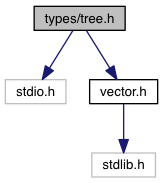tree.h File Reference
Contains the definition of our n-ary Tree. More...
Include dependency graph for tree.h:

This graph shows which files directly or indirectly include this file:

Go to the source code of this file.
Data Structures | |
| struct | Tree |
| Defines the n-ary tree. More... | |
Macros | |
| #define | max(a, b) ((a) > (b) ? (a) : (b)) |
| Computes the maximum of a and b. | |
Typedefs | |
| typedef struct Tree | Tree |
| Defines the n-ary tree. | |
Functions | |
| Tree * | createLeaf (int id, char *str) |
| Create a new leaf. More... | |
| Tree * | createNode (int id, char *str, Tree *child) |
| Create a new node. More... | |
| Tree * | addChild (Tree *node, Tree *child) |
| Add a child to a node. More... | |
| int | isLeaf (Tree *t) |
| Check whether the tree is a leaf or not. More... | |
| int | height (Tree *t) |
| Get the height of a tree. More... | |
| int | depth (Tree *root, int id) |
| Get the depth of a node in the tree. More... | |
| Tree * | LCA (Tree *root, int id1, int id2) |
| Find the lowest common ancestor We traverse from root to leaf. When we find a node matching at least one value, we pass it to its parent. The parent tests whether a child contains the value or not. If yes, the parent is the LCA, otherwise, we pass its parent, up to root. What is passed is the lower node or NULL. More... | |
| void | freeTree (Tree *t) |
| Free the tree. More... | |
| int | isNodeDepthSameOrSmaller (Tree *t, int node1, int node2) |
| Is node1 have same or smaller depth that node2? More... | |
Detailed Description
Contains the definition of our n-ary Tree.
Function Documentation
Add a child to a node.
- Parameters
-
node The node to which to add the child child The child to add to our node
- Returns
- The modified node (same as given as parameter)
Here is the caller graph for this function:

| Tree* createLeaf | ( | int | id, |
| char * | str | ||
| ) |
Create a new leaf.
- Parameters
-
id The value to store in the leaf str String that represents the real name of what is stored
- Returns
- A new leaf
Here is the caller graph for this function:

Create a new node.
- Parameters
-
id The value to store in the node str String that represents the real name of what is stored child The child to add to our new node
- Returns
- A new node
| int depth | ( | Tree * | root, |
| int | id | ||
| ) |
Get the depth of a node in the tree.
- Parameters
-
root The root of the tree id The id of the node of which the depth is needed
- Returns
- The depth of the node in the tree
Here is the caller graph for this function:

| void freeTree | ( | Tree * | t | ) |
Free the tree.
- Parameters
-
t Pointer to the tree
Here is the caller graph for this function:

| int height | ( | Tree * | t | ) |
Get the height of a tree.
- Parameters
-
t The tree of which the height is needed
- Returns
- The height of the tree
Here is the call graph for this function:

| int isLeaf | ( | Tree * | t | ) |
Check whether the tree is a leaf or not.
- Parameters
-
t The tree to check
- Returns
- 1, if the parameter is a leaf, 0 otherwise
Here is the caller graph for this function:

| int isNodeDepthSameOrSmaller | ( | Tree * | t, |
| int | node1, | ||
| int | node2 | ||
| ) |
Is node1 have same or smaller depth that node2?
- Parameters
-
t Pointer to Tree node1 First node node2 Second node
- Returns
- 1, if node1 have same or smaller depth, 0 otherwise
Here is the call graph for this function:

Here is the caller graph for this function:

Find the lowest common ancestor We traverse from root to leaf. When we find a node matching at least one value, we pass it to its parent. The parent tests whether a child contains the value or not. If yes, the parent is the LCA, otherwise, we pass its parent, up to root. What is passed is the lower node or NULL.
- Parameters
-
root The root of the tree id1 The first value id2 The second value
- Returns
- The lowest common ancestor (node or leaf)
Here is the caller graph for this function:



 1.8.11
1.8.11